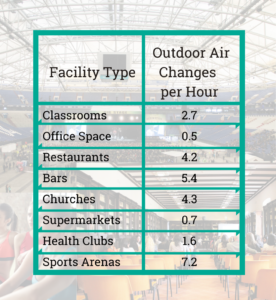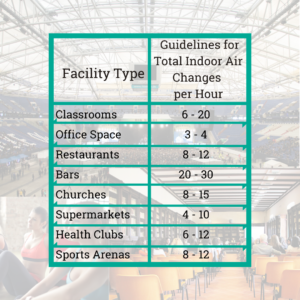Improving Ventilation Part 1: Why, How and What
As the United States begins to open up, one of the biggest concerns is how do we keep people safe in places like schools and offices. Social distancing and wearing protective gear is obviously part of the solution to minimize the potential for transmission. But preliminary studies out of Asia found that the COVID-19 transmission was highest in office spaces that had little to no ventilation. Also, a study conducted in US high schools found that improved ventilation was as effective in preventing influenza transmission as was a 60% flu vaccination coverage. Clearly, improved ventilation in all places where people gather in high numbers needs to be part of the solution to preventing COVID-19 transmission. In the first of this two-part series on Improving Ventilation, I’ll discuss why more ventilation is needed, how much is required and what type of filtration should be used.
Why is Ventilation Needed?
To understand why improving ventilation works, we will start with a discussion of how viruses, such as COVID-19, become airborne. When a person coughs or sneezes, a significant volume of water drops are projected into the air. The heavier droplets will fall out of the air within an average of 6-7 feet. However, the drops under 10 microns can become aerosolized and remain in the air for a significant amount of time. It is these aerosolized droplets containing the live virus that need to be removed from the air by improving ventilation with increased air flow and filtration.
How Much Ventilation is Required?
So now the question is how much ventilation is required? First, let’s look at the American Society of Heating, Refrigerating and Air Conditioning Engineers (ASHRAE) standards. What ASHRAE prescribes is air change rates based on exchanging indoor air for outdoor air. The table below shows the ASHRAE recommendations for some common types of facilities with high people densities:

In addition to the ASHRAE standards for outside air change rates, there are some HVAC industry guidelines for total air change rates inside the space or facility. The table below provides the guideline ranges for the same types of facilities:

You can see that there is a big difference between the ASHRAE recommendations for outdoor air exchange rates and guidelines for total indoor air changes. The reason for this is that ASHRAE recommendations are focused on air quality and the guidelines are focused on temperature and humidity control inside the space.
To better understand how to apply the guidelines and ASHRAE standards, let’s look at an example of a restaurant that has 10,000 cubic feet of dining area. Based on the guidelines, we will assume that the restaurant’s air handing system should change out that 10,000 cubic feet of air 10 times per hour which is in the middle of the guideline range. That means air flow of 100,000 cubic feet per hour will be ducted into the dining area to maintain temperature and humidity when it is at maximum capacity. The ASHRAE standards say that the restaurant needs to provide fresh outdoor air to the dining area of 4.2 changes per hour or 42,000 cubic feet per hour for this example. On the supply side, the air handing system will be sized to heat and cool 100,000 cubic feet per hour. Of that total, 42,000 cubic feet per hour will come from the outside through the outside air dampers in the air handling units. On the exhaust side, the duct work will return 58,000 cubic feet per hour to the air handlers and exhaust 42,000 to the outside through kitchen exhaust hoods, restroom exhaust fans and doorways.
What Type of Filtration?
In my article on Air Filtration Basics, I discussed how HEPA filters are more than 99.94% effective at removing COVID-19 viruses from the air. Adding HEPA filters to the return air portion of the ventilation system will capture the virus and prevent their spread throughout the facility.
Let’s go back to the study on US high schools. Although, the ASHRAE guidelines prescribe an outdoor air change rate of 2.7 times per hour for classrooms, the average rate of the high schools in the study was 0.5 times per hour. Because the return air wasn’t HEPA filtered, most of the influenza virus was being recirculated back into the classrooms. The study authors determined that if high schools implemented the ASHRAE recommendation of outdoor air changes per hour, which would require exhausting a large portion of virus contaminated return air to the outside, there was almost no aerosol transmission of the virus which is the same as if 60% percent of the students had the flu vaccination.
 Another example of using ventilation to mitigate aerosol transmission is a video on YouTube that shows an animation of how the aerosol transmission can be mitigated with the addition of outside air circulation in a restaurant dining area. Both the high school study and the restaurant animation make a great case for using outdoor air or HEPA filtration to remove the aerosolized virus from the recirculated air to reduce COVID-19 transmission.
Another example of using ventilation to mitigate aerosol transmission is a video on YouTube that shows an animation of how the aerosol transmission can be mitigated with the addition of outside air circulation in a restaurant dining area. Both the high school study and the restaurant animation make a great case for using outdoor air or HEPA filtration to remove the aerosolized virus from the recirculated air to reduce COVID-19 transmission.
Conclusion
So, what should we conclude from all of this as we determine how to increase ventilation to combat COVID-19? Our recommendation is that the air handlers for your facility should provide:
- Total air change rate in the range of the guidelines;
- An outside air exchange rate that complies with the ASHRAE recommendations; and
- HEPA filtration for the return air going to the air handlers.
In part two of this series, I’ll discuss what needs to be considered to add additional air flow and HEPA filtration to your existing air handlers.

